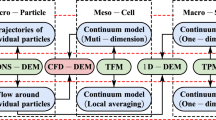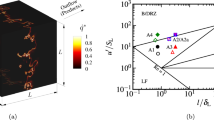Abstract
Combustion simulations involve the modeling of chemical kinetics, and due to the complexity of detailed mechanisms, chemistry reduction techniques are necessary. One model reduction strategy is the reaction-diffusion manifold (REDIM) method, and to obtain the REDIM, an evolution equation must be solved till its stationary solution and a gradient estimation is needed, provided e.g. from flamelet solutions with detailed chemistry. In this work, the REDIM technique is applied to simulate methane/air turbulent flames based on a simplified gradient estimation. This strategy uses less information in constructing the REDIM, increasing computational efficiency while reducing computational costs. Validation is performed for non-premixed laminar flames. A RANS/transported-PDF framework for the simulation of turbulent reacting flows is presented and used to validate the proposed model. Results show that the simplified gradient estimation is enough to simulate turbulent flames at moderate Reynolds number, which demonstrates the suitability of REDIM as reduced kinetic model in reactive flows.
















Similar content being viewed by others
References
Vervisch, L.: Numerical modeling of nonpremixed turbulent combustion. Institut National des Sciences Appliquees de Rouen (1999)
Kuo, K., Acharya, R.: Fundamentals of Turbulent and Multi-Phase Combustion. Wiley, New York (2012)
Peters, N.: Turbulent Combustion. Cambridge University Press, Cambridge (2000)
Pope, S.: Turbulent Flows. IOP Publishing, Bristol (2001)
Warnatz, J., Maas, U., Dibble, R.: Combustion: Physical and Chemical Fundamentals, Modeling and Simulation, Experiments, Pollutant Formation, 4th edn. Springer, Berlin (2006)
Poinsot, T., Veynante, D.: Theoretical and Numerical Combustion, 3rd edn. Inc, RT Edwards (2011)
Echekki, T., Mastorakos, E.: Turbulent Combustion Modeling: Advances, New Trends and Perspectives, vol. 95. Springer, Berlin (2010)
Pitsch, H.: Large-eddy simulation of turbulent combustion. Annu. Rev. Fluid Mech. 38, 453–482 (2006)
Spalding, D.: Mixing and chemical reaction in steady confined turbulent flames. In: Symposium (International) on Combustion, vol. 13, pp 649–657. Elsevier (1971)
Pope, S.: PDF methods for turbulent reactive flows. Prog. Energy Combust. Sci. 11(2), 119–192 (1985)
Haworth, D.: Progress in probability density function methods for turbulent reacting flows. Prog. Energy Combust. Sci. 36(2), 168–259 (2010)
Turányi, T., Tomlin, A.S.: Analysis of kinetic reaction mechanisms. Springer, Berlin (2014)
Lu, T., Law, C.K.: On the applicability of directed relation graphs to the reduction of reaction mechanisms. Combust. Flame 146(3), 472–483 (2006)
Lu, T., Law, C.K.: A directed relation graph method for mechanism reduction. Proc. Combust. Inst. 30(1), 1333–1341 (2005)
Pepiot-Desjardins, P., Pitsch, H.: An efficient error-propagation-based reduction method for large chemical kinetic mechanisms. Combust. Flame 154(1), 67–81 (2008)
Bodenstein, M.: Eine theorie der photochemischen reaktionsgeschwindigkeiten. Zeitschrift für Physikalische Chemie 85(1), 329–397 (1913)
Maas, U., Pope, S.: Simplifying chemical kinetics: intrinsic low-dimensional manifolds in composition space. Combust. Flame 88(3), 239–264 (1992)
Gicquel, O., Darabiha, N., Thévenin, D.: Laminar premixed hydrogen/air counterflow flame simulations using flame prolongation of ILDM with differential diffusion. Proc. Combust. Inst. 28(2), 1901–1908 (2000)
Lam, S.: Using CSP to understand complex chemical kinetics. Combust. Sci. Technol. 89(5-6), 375–404 (1993)
Williams, F.: Recent advances in theoretical descriptions of turbulent diffusion flames. In: Turbulent Mixing in Nonreactive and Reactive Flows, pp 189–208. Springer (1975)
Pierce, C.D., Moin, P.: Progress-variable approach for large-eddy simulation of non-premixed turbulent combustion. J. Fluid Mech. 504, 73–97 (2004)
Oijen, J.V., Goey, L.D.: Modelling of premixed laminar flames using flamelet-generated manifolds. Combust. Sci. Technol. 161(1), 113–137 (2000)
Goussis, D.A., Maas, U.: Model reduction for combustion chemistry. In: Turbulent Combustion Modeling, pp 193–220. Springer (2011)
Griffiths, J.: Reduced kinetic models and their application to practical combustion systems. Prog. Energy Combust. Sci. 21(1), 25–107 (1995)
Løvås, T.: Model reduction techniques for chemical mechanisms. INTECH Open Access Publisher (2012)
Tomlin, A.S., Turányi, T., Pilling, M.J.: Mathematical tools for the construction, investigation and reduction of combustion mechanisms. Comprehensive Chemical Kinetics 35, 293–437 (1997)
Bykov, V., Maas, U.: The extension of the ILDM concept to reaction–diffusion manifolds. Combust. Theor. Model. 11(6), 839–862 (2007)
Bykov, V., Neagos, A., Maas, U.: On transient behavior of non-premixed counterflow diffusion flames within the REDIM based model reduction concept. Proc. Combust. Inst. 34(1), 197–203 (2013)
Bykov, V., Maas, U.: Problem adapted reduced models based on reaction–diffusion manifolds (REDIMs). Proc. Combust. Inst. 32(1), 561–568 (2009)
Fischer, S., Markus, D., Ghorbani, A., Maas, U.: PDF simulations of the ignition of hydrogen/air, ethylene/air and propane/air mixtures by hot transient jets. Zeitschrift für Physikalische Chemie 231(10), 1773–1796 (2017)
Wang, P., Platova, N., Fröhlich, J., Maas, U.: Large eddy simulation of the PRECCINSTA burner. Int. J. Heat Mass Transf. 70, 486–495 (2014)
Wang, P., Zieker, F., Schießl, R., Platova, N., Fröhlich, J., Maas, U.: Large eddy simulations and experimental studies of turbulent premixed combustion near extinction. Proc. Combust. Inst. 34(1), 1269–1280 (2013)
Steinhilber, G., Bykov, V., Maas, U.: REDIM reduced modeling of flame-wall-interactions: quenching of a premixed methane/air flame at a cold inert wall. Proc. Combust. Inst. 36(1), 655–661 (2017)
Schießl, R., Bykov, V., Maas, U., Abdelsamie, A., Thévenin, D.: Implementing multi-directional molecular diffusion terms into reaction diffusion manifolds (REDIMs). Proc. Combust. Inst. 36(1), 673–679 (2017)
Benzinger, M.S., Schießl, R., Maas, U.: A versatile coupled progress variable/REDIM, model for auto-ignition and combustion. Proc. Combust. Inst. 36(3), 3613–3621 (2017)
Pope, S.: A Monte Carlo method for the PDF equations of turbulent reactive flow. Progress Combust. Energy Sci. 25 (1981)
Yu, C., Minuzzi, F., Maas, U.: Numerical simulation of turbulent flames based on a hybrid RANS/Transported-PDF method and REDIM method. Eurasian Chem. Technol. J. 20(1), 23–31 (2018)
Jenny, P., Pope, S., Muradoglu, M., Caughey, D.: A hybrid algorithm for the joint PDF equation of turbulent reactive flows. J. Comput. Phys. 166(2), 218–252 (2001)
Curl, R.: Dispersed phase mixing: i. theory and effects in simple reactors. AIChE J. 9(2), 175–181 (1963)
Cao, R.R., Wang, H., Pope, S.B.: The effect of mixing models in PDF calculations of piloted jet flames. Proc. Combust. Inst. 31(1), 1543–1550 (2007)
Rembold, B., Jenny, P.: A multiblock joint PDF finite-volume hybrid algorithm for the computation of turbulent flows in complex geometries. J. Comput. Phys. 220 (1), 59–87 (2006)
Muradoglu, M., Jenny, P., Pope, S.B., Caughey, D.A.: A consistent hybrid finite-volume/particle method for the PDF equations of turbulent reactive flows. J. Comput. Phys. 154(2), 342–371 (1999)
International workshop on measurement and computation of turbulent nonpremixed flames. [Online]. Available: http://www.sandia.gov/TNF/abstract.html
Barlow, R., Frank, J.: Effects of turbulence on species mass fractions in methane/air jet flames. In: Symposium (International) on Combustion, vol. 27, pp 1087–1095. Elsevier (1998)
Magagnato, F.: SPARC: structured parallel research code. Task Quarterly 2(2), 215–270 (1998)
Maas, U.: Mathematische Modellierung Instationärer Verbrennungsprozesse Unter Verwendung Detaillierter Reaktionsmechanismen. Ph.D. Thesis, Ruprecht-Karls-Universität, Heidelberg, Germany (1988)
Smith, G., Golden, D., Frenklach, M., Moriarty, N., Eiteneer, B., Goldenberg, M., Bowman, C., Hanson, R., Song, S., Gardiner, W., Lissianski, V., Qin, Z.: Gri-mech 3.0. GRI-Mech Home Page, http://www.me.berkeley.edu/gri_mech/ (2011)
Bowman, C., Hanson, R., Davidson, W., Gardiner, W., Lissianski, V., Smith, G., Golden, D., Frenklach, M., Goldenberg, M.: Gri-mech 2.11. GRI-Mech Home Page, http://www.me.berkeley.edu/gri_mech/ (1995)
Ge, Y., Cleary, M., Klimenko, A.: A comparative study of Sandia flame series (D–F) using sparse-lagrangian MMC modelling. Proc. Combust. Inst. 34(1), 1325–1332 (2013)
Cao, R.R., Pope, S.B.: The influence of chemical mechanisms on PDF calculations of nonpremixed piloted jet flames. Combust. Flame 143(4), 450–470 (2005)
Xu, J., Pope, S.B.: PDF calculations of turbulent nonpremixed flames with local extinction. Combust. Flame 123(3), 281–307 (2000)
Yu, C., Bykov, V., Maas, U.: Coupling of simplified chemistry with mixing processes in PDF simulations of turbulent flames. Proc. Combust. Inst. 37(2), 2183–2190 (2019)
Acknowledgements
Financial support by the German Research Foundation (DFG) within the project SFB/TR150 is gratefully acknowledged. F. Minuzzi was supported by CAPES - Brazil, during his stay in Germany, under the grant No 88881.132868/2016-01.
Author information
Authors and Affiliations
Corresponding author
Ethics declarations
Conflict of interests
The authors declare that they have no conflict of interest.
Additional information
Publisher’s Note
Springer Nature remains neutral with regard to jurisdictional claims in published maps and institutional affiliations.
Rights and permissions
About this article
Cite this article
Minuzzi, F., Yu, C. & Maas, U. Simulation of methane/air non-premixed turbulent flames based on REDIM simplified chemistry. Flow Turbulence Combust 103, 963–984 (2019). https://doi.org/10.1007/s10494-019-00059-3
Received:
Accepted:
Published:
Issue Date:
DOI: https://doi.org/10.1007/s10494-019-00059-3




